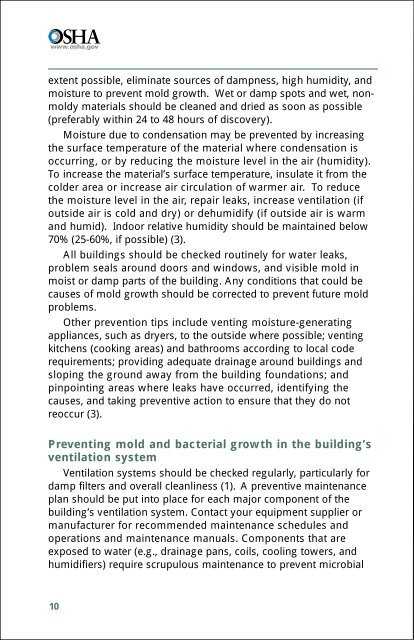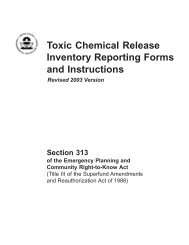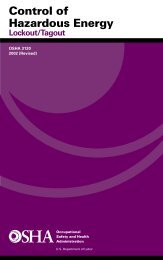Preventing Mold-Related Problems in the Indoor Workplace - Seton ...
Preventing Mold-Related Problems in the Indoor Workplace - Seton ...
Preventing Mold-Related Problems in the Indoor Workplace - Seton ...
Create successful ePaper yourself
Turn your PDF publications into a flip-book with our unique Google optimized e-Paper software.
extent possible, elim<strong>in</strong>ate sources of dampness, high humidity, and<br />
moisture to prevent mold growth. Wet or damp spots and wet, nonmoldy<br />
materials should be cleaned and dried as soon as possible<br />
(preferably with<strong>in</strong> 24 to 48 hours of discovery).<br />
Moisture due to condensation may be prevented by <strong>in</strong>creas<strong>in</strong>g<br />
<strong>the</strong> surface temperature of <strong>the</strong> material where condensation is<br />
occurr<strong>in</strong>g, or by reduc<strong>in</strong>g <strong>the</strong> moisture level <strong>in</strong> <strong>the</strong> air (humidity).<br />
To <strong>in</strong>crease <strong>the</strong> material’s surface temperature, <strong>in</strong>sulate it from <strong>the</strong><br />
colder area or <strong>in</strong>crease air circulation of warmer air. To reduce<br />
<strong>the</strong> moisture level <strong>in</strong> <strong>the</strong> air, repair leaks, <strong>in</strong>crease ventilation (if<br />
outside air is cold and dry) or dehumidify (if outside air is warm<br />
and humid). <strong>Indoor</strong> relative humidity should be ma<strong>in</strong>ta<strong>in</strong>ed below<br />
70% (25-60%, if possible) (3).<br />
All build<strong>in</strong>gs should be checked rout<strong>in</strong>ely for water leaks,<br />
problem seals around doors and w<strong>in</strong>dows, and visible mold <strong>in</strong><br />
moist or damp parts of <strong>the</strong> build<strong>in</strong>g. Any conditions that could be<br />
causes of mold growth should be corrected to prevent future mold<br />
problems.<br />
O<strong>the</strong>r prevention tips <strong>in</strong>clude vent<strong>in</strong>g moisture-generat<strong>in</strong>g<br />
appliances, such as dryers, to <strong>the</strong> outside where possible; vent<strong>in</strong>g<br />
kitchens (cook<strong>in</strong>g areas) and bathrooms accord<strong>in</strong>g to local code<br />
requirements; provid<strong>in</strong>g adequate dra<strong>in</strong>age around build<strong>in</strong>gs and<br />
slop<strong>in</strong>g <strong>the</strong> ground away from <strong>the</strong> build<strong>in</strong>g foundations; and<br />
p<strong>in</strong>po<strong>in</strong>t<strong>in</strong>g areas where leaks have occurred, identify<strong>in</strong>g <strong>the</strong><br />
causes, and tak<strong>in</strong>g preventive action to ensure that <strong>the</strong>y do not<br />
reoccur (3).<br />
<strong>Prevent<strong>in</strong>g</strong> mold and bacterial growth <strong>in</strong> <strong>the</strong> build<strong>in</strong>g’s<br />
ventilation system<br />
Ventilation systems should be checked regularly, particularly for<br />
damp filters and overall cleanl<strong>in</strong>ess (1). A preventive ma<strong>in</strong>tenance<br />
plan should be put <strong>in</strong>to place for each major component of <strong>the</strong><br />
build<strong>in</strong>g’s ventilation system. Contact your equipment supplier or<br />
manufacturer for recommended ma<strong>in</strong>tenance schedules and<br />
operations and ma<strong>in</strong>tenance manuals. Components that are<br />
exposed to water (e.g., dra<strong>in</strong>age pans, coils, cool<strong>in</strong>g towers, and<br />
humidifiers) require scrupulous ma<strong>in</strong>tenance to prevent microbial<br />
10
















